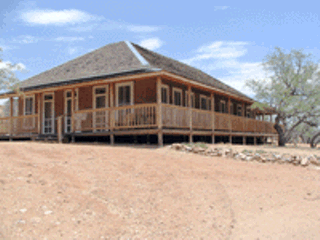The collection of adobe buildings, tucked in the rolling hills of the Santa Rita Mountains not far from Sonoita, is a cool oasis along the Arizona Trail, the pathway that will one day stretch across the entire state. The former mining camp is now an historic site under the control of the U.S. Forest Service.
The ghost town's scenic canyon, dotted with a mix of mesquites, oaks, tall grasses and cacti, might have been thoroughly flattened had plans for a hydraulic mining operation come to fruition. Back in the early 1900s, a California mining engineer named James Stetson came up with an idea to blast the entire canyon with a water-pressure system to clear the way for the recovery of traces of gold ore.
But just one day before Stetson was to meet with a group interested in financing his mad scheme, he toppled out of a window of a downtown hotel and was killed.
Stetson's fall may have been simple carelessness or an act of God, but his bad luck was good fortune for Kentucky Camp, which later fell into the hands of a ranching outfit. The U.S. Forest Service acquired the site in 1989, according to Kathy Makansi, an archaeologist with the Coronado National Forest.
At the time, the buildings on the property were in rough shape. The first order of business was repairing the roofs to keep water off the crumbling adobe walls--a project made possible thanks to a $10,000 donation from the producers of the 1989-1992 TV show The Young Riders, which was then shooting footage in the area.
In the early '90s, volunteers formed the Friends of Kentucky Camp, which has been helping with restoration efforts for more than a decade. The group has rebuilt a cabin, which is now available for overnight rentals as part of the Forest Service's "bed with no breakfast" rental program, says Makansi.
Meanwhile, work is continuing on a larger building that may have once served as a bunkhouse or offices for the mining operation. That building may be open for rental in the fall, according to Makansi.
The trickiest element has been restoring the adobe walls. Makansi says the Forest Service has brought in masons from Mexico's Instituto Nacional de Antropología e Historia to help with the project.
"We've had a hard time finding anyone who can do that kind of fine interior mud plastering in Arizona, so they come up from Mexico to do it," says Makansi.
The Friends of Kentucky Camp come out once a month to work on restoration efforts as well. The adobe buildings require constant maintenance.
"You just continually have to put mud on the walls to keep them from eroding," Makansi says. "It's just never done."
















